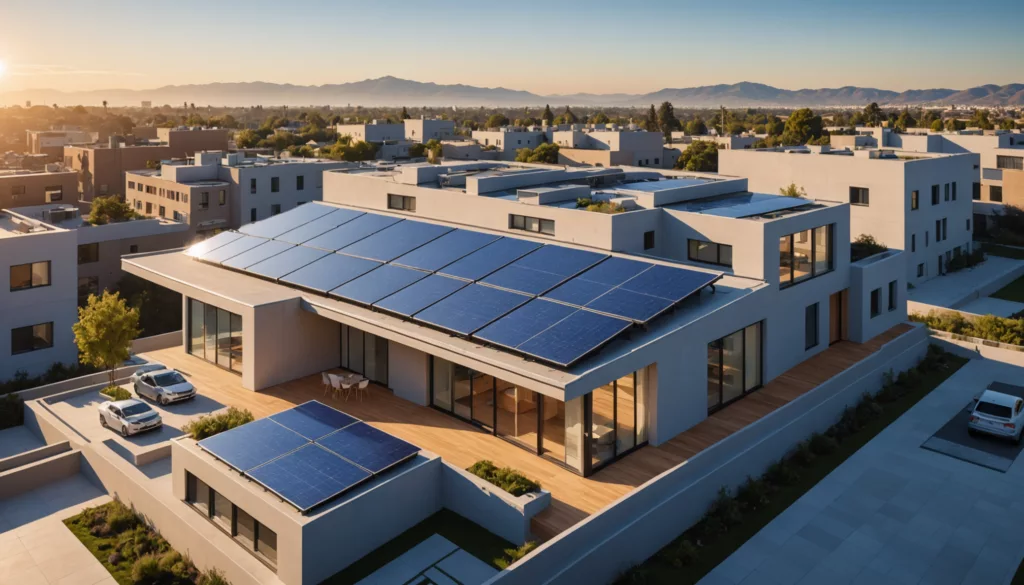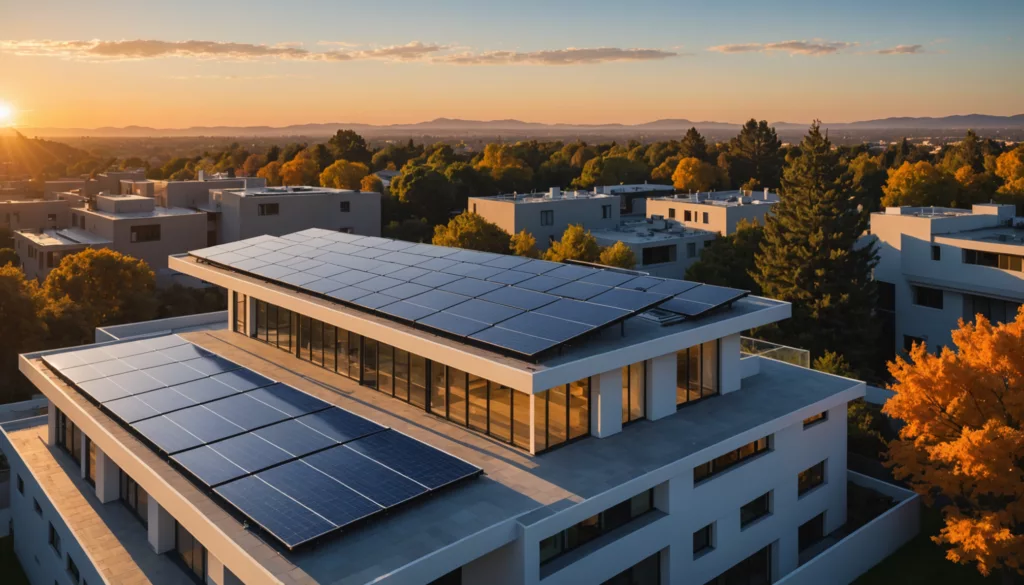How to Calculate Solar Panel Wattage for Maximum Solar Panel Output
Ready to power up your DIY solar project? Learning how to calculate solar panel wattage is your first step toward energy independence and smarter home improvements. Understanding your panels’ power output helps you avoid costly mistakes and ensure your solar installation meets your household’s exact energy needs.
Getting your calculations right means the difference between having abundant clean energy or falling short when you need power most. We’ll explore essential factors like peak sun hours, panel efficiency ratings, and the impact of placement angles on energy production. Plus, you’ll discover practical tools and formulas that make measuring solar output as easy as checking your electric bill. Whether you’re planning a full roof installation or starting with a small solar array, this guide will help you master the math behind solar success.
Understanding Solar Panel Output

What Is Solar Panel Output?
Solar panel output is the power a photovoltaic panel produces, measured in watts (W) or kilowatts (kW). Most residential solar systems generate between 250 and 400 watts under ideal conditions. If you want to know how to calculate solar panel wattage, multiply the panel’s voltage by its current. For example, a 300-watt panel operating at 30 volts and 10 amps produces 300 watts of power.
Factors Affecting Output in Solar Panels
Many factors determine how many watts per panel you can expect. Direct sunlight provides the highest output, while overcast weather conditions reduce daily output.
High temperatures also lower efficiency by up to 0.5% for each degree above 25°C, which impacts the overall power rating (8msolar). Panel orientation, tilt angle, and dust affect the amount of power a panel can produce. Because of normal wear, panels may lose 0.5-1% efficiency each year.
The Role of Solar Cells in Energy Production
Each solar cell converts direct sunlight into electrical energy. About 60 to 72 cells link together in a single module, so you get higher voltage. Monocrystalline solar panels often have higher efficiency, but polycrystalline solar panels also serve many homes or businesses. These variations affect the output of your solar system.
Standard Test Conditions (STC) Explained
Manufacturers rate panels under 1000 W/m² of sunlight, 25°C cell temperature, and an air mass of 1.5. Real-world conditions rarely match those benchmarks, so actual output under ideal conditions is often 10-20% lower than the wattage ratings. This difference helps you set realistic expectations for daily output. (Sinovoltaics)
How to Calculate Solar Panel Wattage

Solar panel wattage indicates the amount of electricity a panel generates under set conditions. This figure depends on voltage, amperage, and various environmental factors. It guides decisions about residential or commercial solar installations, especially when planning energy needs.
Steps to Calculate Solar Panel Wattage
- Identify the panel’s STC (Standard Test Conditions) rating, listed on its specification sheet.
- Multiply the panel’s voltage by its amperage to find the basic wattage.
- Factor in typical efficiency losses (15–20%), which may stem from wiring or real-world conditions.
- Adjust based on the temperature coefficient, since heat can lower output.
A panel with 30 volts and 10 amps has 300 watts of power (30 × 10) under ideal conditions.
Important Variables in Calculation
Many factors affect a solar panel’s daily output or overall power production:
• Solar irradiance (measured in watts per square meter)
• Weather conditions such as cloud cover or humidity
• Panel tilt angle for maximum sunlight reception
• Shading from trees or nearby objects
• Seasonal changes in daylight hours
These variables determine how much electricity the panel can produce and help estimate solar panel performance.
Understanding kWh and Its Impact on Energy Output
Kilowatt-hours (kWh) measure energy over time. Multiplying panel wattage by hours of peak sunlight provides the total watt-hours. Dividing that figure by 1,000 converts watt-hours to kWh. For instance, a 300-watt panel with five hours of peak sunlight produces 1.5 kWh (300 × 5 ÷ 1,000).
Using Digital Tools and Apps for Calculations
Digital platforms refine solar panel power output estimates by including real-world data. Tools like PVWatts or Solar-Estimate.org calculators combine local weather patterns, panel wattage ratings, and on-site conditions. Some manufacturers also offer mobile apps that measure available roof space and generate accurate quotes to help identify the number of solar panels needed.
How Much Energy Can Solar Panels Produce?

Solar panels turn sunlight into electricity through small photovoltaic cells. They usually measure between 250 and 400 watts of power rating and can produce around 1 to 1.5 kilowatt-hours (kWh) per day per panel under ideal conditions. Typical residential solar panels reach 15-20% efficiency, which influences daily output and overall energy use. (Solarreviews)
Average Solar Panel Energy Production per Hour
A 350-watt residential solar panel may generate more energy during peak sunlight hours (around midday) and less at dawn or dusk. Under normal conditions, it reaches 280-350 watts per hour at midday but drops to nearly half that amount early or late in the day.
| Time of Day | Watts Produced | % of Maximum Output |
|---|---|---|
| 6-8 AM | 70-140 | 20-40% |
| 8-10 AM | 140-280 | 40-80% |
| 10 AM-2 PM | 280-350 | 80-100% |
| 2-4 PM | 140-280 | 40-80% |
| 4-6 PM | 70-140 | 20-40% |
How Many Solar Panels Does an Average American Household Need?
An average home in the United States consumes about 886 kWh of electricity per month. To meet this demand, a home may need 20-24 panels for complete coverage, totaling 6-8 kilowatts (kW) of system capacity. Regional differences occur because peak sun hours and weather patterns vary across the country.
Assessing Solar Power Output in Different Conditions
Weather conditions and panel orientation affect daily output. High temperatures can lower efficiency by 0.3-0.5% for each degree above 77°F (Ecoflow), while cloud cover reduces solar panel power output by up to 25% (Sunpower). Dust or dirt accumulation can also drop production by 2-5%, making regular cleaning important for maximizing power generation.
Seasonal Variations in Energy Production
Solar system production peaks in summer when sunlight is strongest and days are longest. During winter, panels may deliver only 30-60% of their rated capacity because of shorter days and lower sun angles. Spring and fall often provide moderate output at around 60-80% of maximum potential output.
Calculating the Impact of Shade on Solar Panel Output

Shade disrupts the daily output of solar power systems and lowers the number of watts each panel can produce. By understanding shade effects, you can estimate solar panel performance in realistic conditions.
How Shade Affects Solar Panel Efficiency
Shade blocks light from reaching the cells, causing the entire panel’s voltage and wattage ratings to drop. When 20% of a panel is in shadow, output can drop by 50–80% due to the way cells connect in series. Bypass diodes help reroute electricity around shaded areas, but production still decreases.
Key points to remember:
• Even partial shade on a solar system cuts output drastically
• Uniform shade often reduces fewer watts per panel than sporadic shadows
• Morning and evening shade can cause 20–30% annual production loss
Adjusting Calculations Based on Partial Shade
You can calculate solar panel wattage under shade using a simple formula. Multiply the panel’s rated output by (1 – Shade Factor), where the Shade Factor ranges from 0.2 for light shade to 0.8 for heavy coverage.
| Shade Condition | Typical Shade Factor |
|---|---|
| Light Morning/Evening | 0.2–0.3 |
| Partial Tree Cover | 0.4–0.6 |
| Heavy Shade | 0.7–0.8 |
Best Practices for Solar Panel Placement to Minimize Shade
Place panels where they receive the maximum amount of sunlight and face minimal obstruction. This approach preserves daily energy output and supports higher efficiency of a solar panel.
Consider these tips:
• Install panels at least 4 ft from roof obstacles
• Trim nearby trees that block direct sunlight
• Avoid morning/evening shade if possible
• Mount panels where seasonal sun paths stay clear
Using Shade Analysis Tools
Shade analysis tools allow you to identify potential shadow patterns and predict actual output under real-world conditions. These resources reveal when and where obstacles cast shade, helping you plan your solar installation effectively.
Common solutions include:
• Solar pathfinder for seasonal mapping
• AR-based smartphone apps for quick measurements
• Digital solar assessment tools for accurate quotes
Expert Recommendations on Maximizing Solar Power Output

Choosing the Right Solar Panels for Individual Needs
Modern solar panels range from 250 to 400 watts per panel and are measured in watts. Monocrystalline solar panels often reach 15-22% efficiency, while polycrystalline panels may offer 13-17%. Factors like available roof space, panel orientation, and specific energy needs affect the final choice. Many installations match wattage ratings to projected daily output, ensuring the panel can produce the desired amount of power under ideal conditions.
Understanding Solar Panel Efficiency Ratings
Solar panel power output under Standard Test Conditions (STC) assumes 1000W/m² solar irradiance and a 25°C cell temperature. Real-world solar power systems rarely match STC levels because of weather conditions, solar panel’s voltage fluctuations, and panel age. Efficiency of a solar panel typically falls 15-25% below STC estimates. Calculations often include local climate data and the number of solar panels needed to meet daily energy requirements.
Common Misconceptions About Solar Panel Energy Production
| Misconception | Reality |
|---|---|
| Higher cost means better performance | Price does not always guarantee higher wattage ratings |
| More sun equals more power | Warmer temperatures can reduce output of a solar panel |
| Partial shade has minimal impact | Even slight shade can cut efficiency by 25-100% |
Some assume larger panels deliver maximum power output at all times, but daily energy production depends on atmospheric conditions and proper solar installation.
Latest Technologies in Solar Panel Optimization
Bifacial panels capture light on both sides and can increase total energy output by 5-30%. Smart optimizers raise system efficiency by 5-10%, while anti-reflective coatings add 2-3% more energy capture. Microinverters also help each panel perform at its best, even if partial shade affects one section of a solar system. This approach maintains strong power generation across residential solar and commercial solar setups.
Real-World Case Studies

Real-world examples show how to calculate solar panel wattage for optimal performance in residential solar power systems. Each success story confirms that accurate wattage ratings, a proper assessment of weather conditions, and careful planning lead to strong returns.
Residential Installation Success Stories
The Smith family’s 8.5 kW residential solar panel system produces an average daily output of 34 kWh. They save about $2,180 each year and expect full cost recovery in around 7.2 years. Meanwhile, the Green Valley Community Project involves 15 households with 6.2 kW systems on average. These panels maintain 92% of projected production and stay within 3% of pre-installation wattage estimates.
ROI Analysis and Energy Savings
Recent estimates show installation costs ranging from $2.65 to $3.25 per watt. When you size panels correctly, you often reduce electricity bills by 50-90%. Most owners see payback in 5-8 years thanks to monthly savings of $120-$180 and a 30% federal tax credit. Systems usually last 25-30 years, delivering 200-300% overall return and raising property values by about 4.1%.
Common Installation Challenges and Solutions
Many installations underestimate actual energy needs by 32%. This often happens when you overlook shade or fail to factor in seasonal weather. Shade alone can lower efficiency by 20-40%, and weather shifts cause a 10-25% drop in daily output. Proven solutions include using multiple calculation methods, professional tools, and regular monitoring. These steps lift accuracy to about 94%, which helps your solar system deliver its expected output.
Conclusion
Understanding solar panel wattage and output is key to making smart energy choices for your home. By learning how to calculate solar panel output and considering factors like sunlight hours, panel efficiency, and shade impact, you can better plan your solar power system. Making informed decisions about solar panels starts with understanding the numbers behind their performance.
Whether you’re interested in reducing your energy bills or helping the environment, solar power is an exciting solution. Remember that panel placement, seasonal changes, and weather conditions all affect how much energy your panels can produce. With the right calculations and setup, you can harness the sun’s power to create clean, renewable energy for years to come. Keep exploring solar technology – it’s getting better and more efficient every year!
FAQs
1. What affects solar panel wattage?
Different factors influence how many watts your solar panel can produce. Sunlight intensity (solar irradiance) and panel orientation affect daily output. High temperatures reduce efficiency of a solar panel by about 0.5% per degree above 25°C. Dust, shade, and age also lower a panel’s maximum power output over time. Panel technology, such as monocrystalline solar panels or polycrystalline solar panels, can impact solar wattage, too.
2. How do I calculate my home’s solar needs?
Begin by reviewing 12 months of electricity bills to find your monthly kWh usage. Divide that number by 30 to estimate daily usage, then factor in peak sun hours for your area. Use this simple formula: daily kWh ÷ peak sun hours = system size in kilowatts. Add around 20% for losses in your residential solar power systems, and multiply by the wattage ratings of each panel to decide how many panels you may need to install.
3. What is the average solar panel efficiency?
Most residential solar panels have an efficiency of 15-20%, while premium panels reach 20-23%. These higher wattage modules require less available roof space to meet your energy needs. In best-case lab settings, single-junction panels can approach 26.7% efficiency. Higher efficiency panels often cost more but can produce more energy in limited space.
4. How does weather impact solar output?
Clouds can cut solar panel power output by 10-90% depending on thickness. Cooler days improve efficiency, while hot weather raises panel temperature and lowers performance. Rain can clean off debris, but production drops when sunlight is blocked. Snow layers stop output until they thaw, and strong winds can help cool panels for a slight boost in power generation.







